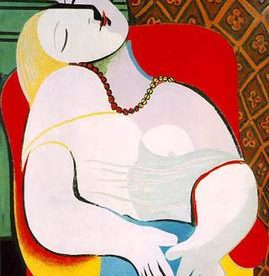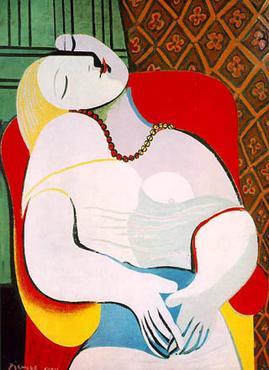Picasso with the Sharp Elbows


The image above is one of the best-known masterpieces by Spanish painter Pablo Picasso. Titled “Le Rêve,” it was 50-year-old Picasso’s effort — through cubism — to paint his 22-year-old mistress in a rather erotic way, with some not-so-subtle depictions of various body parts. (I’ll leave it to you to see whatever you see.) And t’s worth a small fortune: in 2001, casino giant Steve Wynn purchased the painting for an estimated $60 million.
For Wynn, Le Rêve was more than just something nice to hand on a wall — it was the centerpiece of his collection and more. In 2005, to much fanfare, Wynn opened up a new casino and resort in Las Vegas, and he ultimately named it after himself (literally, “Wynn Las Vegas”). But that was reportedly his second choice — he originally wanted to name the hotel Le Rêve, after the painting, but reconsidered shortly before opening. (There is, instead, a show at the hotel named for the painting.) That proved to be a good idea because in 2006, a hedge fund manager named Stephen A. Cohen made Wynn an offer he couldn’t refuse. Cohen told Wynn he’d pay $139 million — the highest price ever for a work of art, and more than twice what Wynn paid — for the Picasso masterpiece.
The contracts were drafted, the I’s dotted and T’s crossed, and the documents were signed. All that had to happen was the exchange: money from Cohen, a painting from Wynn. But just a few days before the swap was to occur, Wynn had some notable guests over — Barbara Walters, Nora Ephron, and some others. Wynn mentioned the sale and the guests were, understandably, curious — they wanted to see this record-setting painting first-hand. Wynn obliged, but … he probably shouldn’t have. The New Yorker explains what happened next:
The guests came at five-thirty, and Wynn ushered them in. On the wall to his left and right were several paintings, including a Matisse, a Renoir, and “Le Rêve.” The other three walls were glass, looking out onto an enclosed garden. He began to tell the story of the Picasso’s provenance. As he talked, he had his back to the picture. He was wearing jeans and a golf shirt. Wynn suffers from an eye disease, retinitis pigmentosa, which affects his peripheral vision and therefore, occasionally, his interaction with proximate objects, and, without realizing it, he backed up a step or two as he talked. “So then I made a gesture with my right hand,” Wynn said, “and my right elbow hit the picture. It punctured the picture.” There was a distinct ripping sound. Wynn turned around and saw, on Marie-Thérèse Walter’s left forearm, in the lower-right quadrant of the painting, “a slight puncture, a two-inch tear.”
Oops.
Wynn, shockingly, took the damage in stride. Per NPR, the casino mogul was glad it wasn’t one of his guests that damaged the masterpiece, stating “oh [explitive], at least it was me.” And the painting could be repaired to a reasonable degree at a similarly reasonable price (given the underlying value) of $90,000.
And in the end, Wynn somehow came out ahead. The art restorer told him that the damage would dramatically reduce the painting’s value, but Cohen didn’t agree — in 2013, he bought Le Rêve from Wynn for $155 million. Adjusting for inflation, that’s almost the same price he had offered seven years prior.
Bonus fact: In 1911, the Mona Lisa was stolen from the Louvre. (More on that is below.) One of the first suspects was, as Mental Floss notes, “one of the country’s most promising young artists: Pablo Picasso.” Picasso was indeed in possession of two other pieces that had been taken from the Louvre (although it’s unclear if he knew they were stolen), and authorities believed that he may have been hiding even more stolen works. They arrested Picasso in connection to the Mona Lisa theft but the charges were ultimately dropped.
From the Archives: Stolen Smile: The theft of the Mona Lisa; Picasso, rightfully, is not part of the story.
